Maximizing Your Sales Potential on Amazon in 2024: 5 Proven tactics for effective selling.
As we approach 2024, it becomes crucial for sellers to implement effective tactics to maximize their sales on this platform. In this article, we will explore five proven tactics that can help you boost your sales on Amazon.
1. Choosing the right business model on Amazon
Amazon has revolutionized the way businesses operate, providing a platform that caters to a wide range of business models. Whether you are an individual entrepreneur, a small business owner, or a large corporation, Amazon offers various business models to suit your specific needs and goals. Let’s talk about the 7 different types of business models on Amazon:

Private Label:
Private label selling involves creating your own brand and sourcing products from manufacturers or suppliers. With this model, you can differentiate your products from competitors and establish a unique brand identity. You’ll have control over product quality, pricing, and branding, offering the potential for higher profit margins and long-term brand growth.
Retail Arbitrage:
Retail arbitrage involves sourcing products from retail stores, clearance sales, or liquidation sales at a lower price and reselling them on Amazon for a profit. Sellers in this model capitalize on price discrepancies between retail and online markets. However, it requires careful product research, knowledge of market trends, and effective inventory management to ensure consistent availability and competitive pricing.
Online Arbitrage:
Online arbitrage involves sourcing products from online marketplaces, such as eBay, at a lower price and reselling them on Amazon. This model allows sellers to leverage the vast product selection available on other platforms and tap into new markets. Successful online arbitrage requires efficient sourcing strategies, competitive pricing, and effective inventory management.
Wholesale:
Wholesale selling involves purchasing products in bulk directly from manufacturers or authorized distributors at a discounted price and reselling them on Amazon. This model offers the advantage of accessing established brands and a wide range of products. Building relationships with suppliers and negotiating favorable pricing terms are crucial for success in the wholesale model.
Handmade:
The handmade model is designed for artisans and craftsmen who create unique, handcrafted products. Amazon’s Handmade platform provides a dedicated space for sellers to showcase and sell their handmade items. This model caters to artisans looking to reach a broader customer base. Handmade sellers benefit from the growing demand for authentic, artisanal products and the exposure provided by Amazon’s vast customer base.
Merch by Amazon:
Merch by Amazon is a print-on-demand service that allows sellers to create and sell custom-designed apparel and other merchandise. With this model, sellers can focus on design creation and marketing while Amazon handles product production, shipping, and customer service.
Dropshipping:
Dropshipping is a business model where sellers don’t hold inventory themselves. Instead, they partner with suppliers or manufacturers who handle the storage, packaging, and shipping of products directly to customers. Sellers list the products on Amazon and fulfill orders by forwarding them to the supplier. It requires strong communication and coordination with suppliers to ensure timely order fulfillment and customer satisfaction.
Amazon’s diverse range of business models provides opportunities for entrepreneurs and businesses of all sizes to thrive in the e-commerce space. With careful planning, product research, and effective utilization of Amazon’s tools and services, you can harness the power of Amazon’s marketplace to drive growth and success in your chosen business model.
2. Amazon Seller Central
Amazon Seller Central is a powerful platform that empowers individuals, small businesses, and large enterprises to sell their products on Amazon’s vast marketplace. Creating an Amazon seller account is a straightforward process that involves providing basic business information, setting up payment and shipping preferences, and agreeing to Amazon’s terms and policies. Once registered, sellers gain access to a wide range of tools and features to manage their online business.
One significant advantage of using Amazon Seller Central with fulfillment options, such as Fulfillment by Amazon (FBA), is the convenience it offers.
On the other hand, Amazon Vendor Central is an invitation-only platform where Amazon acts as the retailer, purchasing products directly from vendors and managing the selling process themselves. While Vendor Central offers the advantage of selling in bulk to Amazon and potentially reaching a broader customer base, it also means giving up control over pricing and inventory management.
Additionally, the Amazon Seller App is a valuable tool for sellers on the go. It allows sellers to monitor their sales, manage inventory, respond to customer inquiries, and track shipments right from their mobile devices. The app provides real-time insights and notifications, enabling sellers to stay connected and make informed decisions.
3. FBA or FBM: the appropriate fulfillment option for your business
Add Your Heading Text Here
On Amazon, sellers have two main fulfillment options: FBA (Fulfillment by Amazon) and FBM (Fulfillment by Merchant).
With FBA, sellers store their products in Amazon’s fulfillment centers. When a customer places an order, Amazon takes care of the packaging, shipping, and customer service. FBA offers access to Amazon Prime customers, but sellers need to pay fees for storage and fulfillment services.
On the other hand, FBM means sellers handle the entire fulfillment process themselves, including inventory storage, packaging, and shipping. FBM gives sellers more control over the process but requires them to manage logistics and customer inquiries.
The choice between FBA and FBM depends on factors like business size, resources, and desired level of involvement in order fulfillment.
Leveraging specialized expertise and services in the field of e-commerce to bolster your selling potential on Amazon and attain exceptional outcomes.
4. Amazon's expenditure framework: things to consider
Amazon’s cost structure encompasses various components that contribute to its operations and profitability. Here are the key elements of Amazon’s cost structure:
- Selling plan fees and referral fees (average referral fees around 15%)
- Other optional fees like FBA fees, deal closing fees, high volume listing fees, refund administration fees, etc…
5. Amazon pricing strategy
Amazon employs a thoughtfully crafted and dynamic pricing strategy that empowers sellers to thrive in the competitive e-commerce landscape.
The ability to track competitors and adjust pricing strategies accordingly: Stay vigilant of competitors within your industry. Maintain a proactive approach in keeping abreast of their strategies and keeping a close watch on their pricing structures and product/service features.
Dynamic pricing strategy: Amazon enables sellers to leverage dynamic pricing, a strategy that dynamically adjusts prices based on various factors such as demand, seasonality, and market conditions. With that, sellers can maximize sales opportunities, capture customer interest, and respond swiftly to market fluctuations.
Is there any tool available to simplify your tasks on Amazon?
Luckily, the answer is YES! Book a demo today with our technical support to assist you with your integration. By harnessing the knowledge and services of industry professionals in e-commerce, you can amplify your selling potential on Amazon and achieve remarkable results.
Recent Posts
Categories
- Amazon Integration (4)
- eCommerce Strategies (3)
- Selling On Amazon (9)
- Shopify (2)
- Uncategorized (1)


